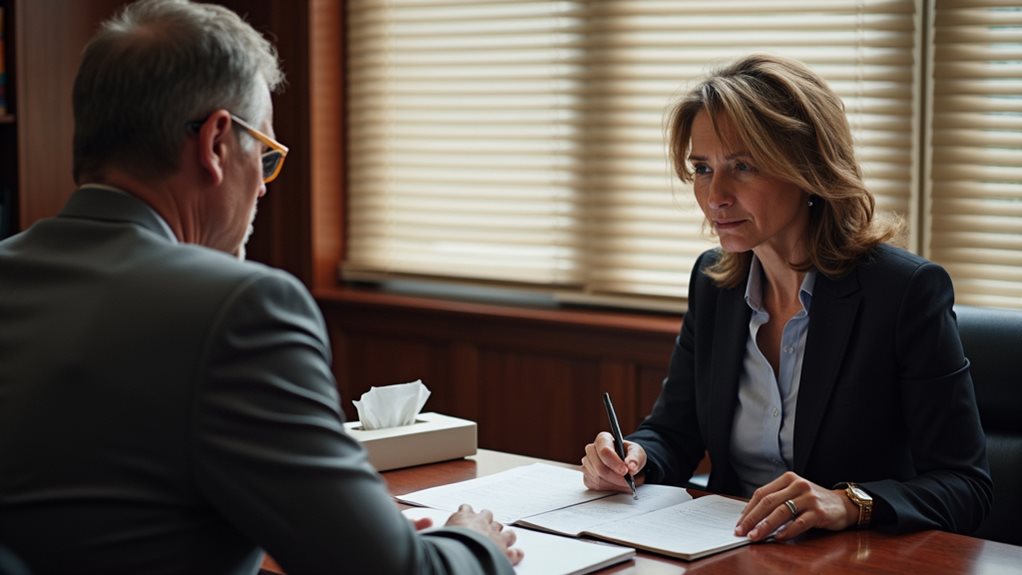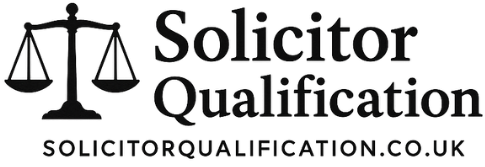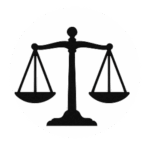You’ll become a better lawyer through effective client communication because it directly impacts case outcomes and builds essential trust. By mastering active listening, managing expectations, and delivering clear written correspondence, you’ll create stronger attorney-client relationships that lead to more successful resolutions. When you combine traditional communication skills with modern technology and empathetic problem-solving approaches, you’ll elevate your practice to new heights. Let’s explore the key strategies that transform good lawyers into exceptional ones.
The Impact of Clear Communication on Case Outcomes

While many factors influence legal outcomes, clear communication stands as one of the most essential elements in determining a case’s success.
When you’re able to effectively convey complex legal concepts to your clients, you’ll find they make better-informed decisions that align with your case strategy.
You’ll need to adapt your communication styles to match each client’s level of understanding, ensuring they grasp vital details without feeling overwhelmed.
Building Trust Through Active Listening Skills
Anyone who’s mastered the art of active listening knows it’s the cornerstone of building trust with clients. When you demonstrate active engagement during client meetings, you’ll create an environment where clients feel genuinely heard and understood. Your empathetic responses signal that you’re fully present and invested in their concerns.
To elevate your active listening skills, focus on these essential practices:
- Maintain appropriate eye contact while taking minimal notes to show undivided attention
- Use non-verbal cues like nodding and leaning forward to demonstrate engagement
- Reflect key points back to clients using their own words to confirm understanding
Managing Client Expectations and Emotions
Setting clear boundaries with your clients from the initial consultation helps establish realistic expectations and prevents future misunderstandings about your role and the legal process.
You’ll find that being upfront about timelines, potential outcomes, and communication protocols creates a foundation of transparency that serves both you and your client throughout your professional relationship.
When handling emotionally charged situations, it’s crucial to maintain your professional composure while acknowledging your client’s feelings, helping them navigate their stress without compromising the legal strategy or your boundaries.
Setting Clear Boundaries Early
Establishing clear boundaries with clients from day one creates the foundation for a successful attorney-client relationship. During initial consultations, you’ll need to communicate your policies explicitly and set realistic expectations about your availability and response times.
Essential aspects of boundary enforcement include:
- Defining acceptable communication methods and hours of availability
- Clarifying fee structures and payment expectations
- Setting guidelines for emergency contact procedures
You’ll find that clear boundaries protect both you and your clients from misunderstandings while fostering mutual respect.
It’s vital to document these boundaries in your retainer agreement and reinforce them through consistent practice. When clients understand the parameters of your professional relationship early on, they’re more likely to respect your time and work processes, leading to smoother interactions and better outcomes for everyone involved.
Managing High-Stress Legal Situations
Legal matters often trigger intense emotional responses from clients, making your role as both counselor and emotional anchor particularly important.
You’ll need to master stress management techniques while maintaining professional composure, even when clients are distressed or angry.
Effective client reassurance begins with acknowledging their concerns while setting realistic expectations.
When facing high-stakes situations, break down complex legal processes into digestible segments, helping clients understand each step of their case.
You’ll want to establish a communication rhythm that keeps them informed without overwhelming them with unnecessary details.
Remember to document all significant conversations and decisions, protecting both you and your client during emotionally charged moments. Additionally, applying strategies like active listening can foster a deeper connection with clients, allowing you to better address their emotional needs.
Best Practices for Written Client Correspondence
Written communication forms the backbone of attorney-client relationships, serving as a permanent record of advice, decisions, and case developments. Your written correspondence should reflect professionalism while maintaining clarity and accessibility.
When crafting client communications, establish standardized correspondence templates that guarantee consistency while allowing for personalization.
To maximize the effectiveness of your written communications:
- Structure your messages with clear headings and organized paragraphs that guide readers through complex legal concepts.
- Include specific deadlines, action items, and next steps to manage client expectations and maintain accountability.
- Request client feedback on your communications to refine your approach and guarantee your messages resonate with their needs.
Remember to maintain precise language while avoiding legal jargon that might confuse clients. This balance helps build trust and facilitates better understanding between you and your clients.
Navigating Difficult Conversations With Confidence

Maneuvering tough client conversations requires strategic preparation, starting with setting clear expectations about what you’ll discuss and potential outcomes before the meeting begins.
When tensions arise, you’ll need to actively listen without becoming defensive, acknowledging your client’s concerns while maintaining professional composure.
Keep the discussion focused on finding practical solutions, steering the conversation away from blame and toward concrete next steps that address your client’s needs.
Set Clear Expectations First
Successful client relationships in law begin with establishing crystal-clear expectations from the very first meeting. When you’re setting priorities and defining objectives with clients, it’s essential to outline precisely what they can expect from your representation.
To maintain transparency and build trust, make certain you’ve covered these important elements:
- Clear timelines for case milestones and anticipated resolution
- Specific communication protocols, including response times and preferred methods
- Detailed breakdown of fees, costs, and billing procedures
You’ll find that managing expectations early helps prevent misunderstandings and reduces client anxiety throughout the legal process.
It’s imperative to document these discussions and provide written summaries for reference.
Listen Without Getting Defensive
Legal professionals often encounter challenging moments when clients express frustration, doubt, or dissatisfaction with case progress. When faced with these situations, you’ll need to resist the natural urge to defend your actions or dismiss their concerns.
Instead, practice empathetic listening by maintaining eye contact, acknowledging their emotions, and allowing them to fully express their perspective without interruption.
Create effective feedback loops by periodically restating their concerns to guarantee you’ve understood correctly. You might say, “I hear that you’re worried about the timeline for discovery. Let me make sure I understand your specific concerns.”
This approach demonstrates your commitment to their needs while giving you valuable insights. Remember, a defensive response can escalate tensions, while active listening builds trust and often leads to more productive client relationships.
Stay Solutions-Focused Throughout
When clients raise challenging issues, maintaining a solutions-oriented mindset becomes essential for steering conversations toward productive outcomes. By adopting proactive problem solving approaches, you’ll transform difficult discussions into opportunities for resolution.
Focus on identifying actionable steps while acknowledging your client’s concerns.
To effectively maintain a solution oriented mindset, consider these key strategies:
- Ask targeted questions that reveal underlying needs and potential paths forward
- Present multiple options when discussing possible resolutions, empowering clients to participate in decision-making
- Document agreed-upon action items and next steps to maintain momentum
Remember that your role extends beyond just legal counsel – you’re a strategic partner in finding solutions.
Technology and Modern Client Communication Strategies
Modern technology has revolutionized how lawyers connect with their clients, offering unprecedented opportunities for streamlined communication and enhanced service delivery.
You’ll find that virtual consultations have become essential tools, allowing you to meet with clients regardless of geographic constraints. By leveraging mobile communication platforms, you can provide timely updates and maintain consistent contact while managing your practice efficiently.
To maximize these digital advantages, you’ll need to establish clear protocols for online interactions. Implement secure messaging systems, schedule regular video check-ins, and utilize practice management software to track client communications.
Remember that while technology enables faster response times, it’s vital to maintain professional boundaries and set realistic expectations for availability. The key is finding the right balance between accessibility and maintaining the high-quality service your clients expect.
Frequently Asked Questions
How Often Should I Update My Clients on Their Case Status?
You should establish case update frequency based on your client’s communication preferences. Update them monthly at minimum, immediately for significant developments, and confirm these expectations during your initial consultation to guarantee satisfaction.
What’s the Best Way to Handle a Client Who Constantly Calls?
Studies show 76% of client complaints stem from poor communication. You’ll need to establish clear boundaries, setting specific times for calls and updates while documenting communication preferences to maintain professional control of client interactions.
Should I Communicate Differently With Corporate Versus Individual Clients?
You’ll need to adapt your communication style for each client type. Corporate expectations often demand formal, structured updates to multiple stakeholders, while individual preferences typically call for more personal, direct interaction and simplified explanations.
How Do I Bill for Time Spent on Client Communications?
Did you know 67% of lawyers struggle with time tracking? You’ll maximize billable hours by documenting all client communications immediately, using precise billing methods to capture emails, calls, and texts in real-time—don’t wait until later.
What Privacy Protocols Should I Follow When Using Social Media With Clients?
Don’t connect with clients on personal social media. Follow strict social media guidelines to protect client confidentiality. You should maintain separate professional accounts and never discuss case details on any platform.
Final Thoughts
Like a finely tuned instrument in an orchestra, your communication skills will make or break your legal practice. You’ll find that mastering client communication isn’t just about conveying information – it’s about building lasting relationships, managing expectations, and delivering results. By implementing these strategies for clear, empathetic, and tech-savvy communication, you’re positioning yourself to become not just a better lawyer, but a trusted advisor your clients can count on.


